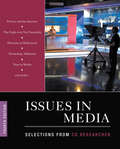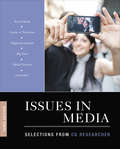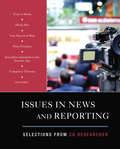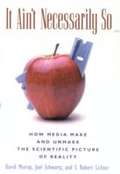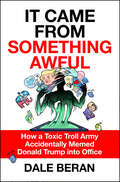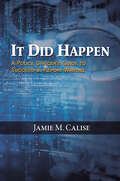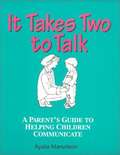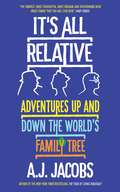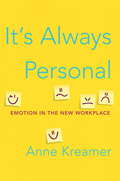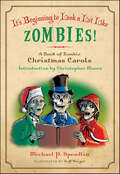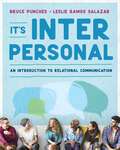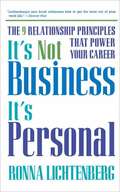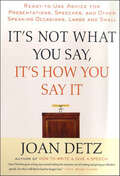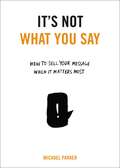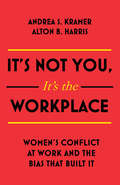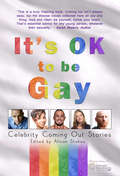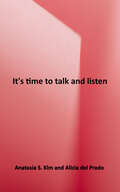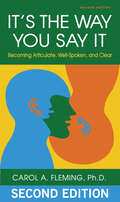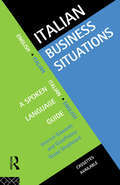- Table View
- List View
Issues in Media: Selections from CQ Researcher
by CQ ResearcherWhat is the future of television? Do social media and big data threaten privacy rights? Do children have too much access to violent media content? Is reporting on global conflict worth the risk? These questions—and many more—are at the heart of today’s media landscape. Written by award-winning CQ Researcher journalists, this collection of non-partisan reports focuses on fifteen hot-button issues impacting the media. With reports ranging from the fight over net neutrality to social media and politics, Issues in Media promotes in-depth discussion, facilitates further research, and helps readers formulate their own positions on crucial issues. And because it’s CQ Researcher, the reports are expertly researched and written, presenting readers with all sides of an issue. Key Features: Chapters follow a consistent organization, beginning with a summary of the issue, then exploring a number of key questions around the issue, next offering background to put the issue into current context, and concluding with a look ahead. A pro/con debate box in every chapter offer readers the opportunity to critically analyze and discuss the issues by exploring a debate between two experts in the field. All issues include a chronology, a bibliography, photos, charts, and figures to offer readers a more complete picture of the issue at hand.
Issues in Media: Selections from CQ Researcher
by CQ ResearcherWhat is the future of television? Do social media and big data threaten privacy rights? Do children have too much access to violent media content? Is reporting on global conflict worth the risk? These questions—and many more—are at the heart of today’s media landscape. Written by award-winning CQ Researcher journalists, this collection of non-partisan reports focuses on fifteen hot-button issues impacting the media. With reports ranging from the fight over net neutrality to social media and politics, Issues in Media promotes in-depth discussion, facilitates further research, and helps readers formulate their own positions on crucial issues. And because it’s CQ Researcher, the reports are expertly researched and written, presenting readers with all sides of an issue. Key Features: Chapters follow a consistent organization, beginning with a summary of the issue, then exploring a number of key questions around the issue, next offering background to put the issue into current context, and concluding with a look ahead. A pro/con debate box in every chapter offer readers the opportunity to critically analyze and discuss the issues by exploring a debate between two experts in the field. All issues include a chronology, a bibliography, photos, charts, and figures to offer readers a more complete picture of the issue at hand.
Issues in Media: Selections from CQ Researcher
by Cq ResearcherWhat is the future of television? What is the impact of media violence on society? Is news quality better or worse online? Should we regulate internet and social media use, and if so, how? Will traditional print books disappear from the marketplace? These are just a sampling of the important, provocative questions in this new reader, sure to provide a solid foundation to spark lively classroom discussion. For current coverage of controversial and important issues centering on media, look to the balanced reporting, complete overviews and engaging writing that CQ Researcher has consistently provided for more than eighty years. This brief reader allows students to see the links between media, culture, business and politics, and an opportunity to view the issues from all sides while giving them a window into the relationships between media, culture, business, and politics. In addition, useful pedagogical features—pro/con debates, graphs, tables, photos, suggested readings, and bibliographies—advance critical thinking and help in study and review.
Issues in Media: Selections from CQ Researcher
by Cq ResearcherWhat is the future of television? What is the impact of media violence on society? Is news quality better or worse online? Should we regulate internet and social media use, and if so, how? Will traditional print books disappear from the marketplace? These are just a sampling of the important, provocative questions in this new reader, sure to provide a solid foundation to spark lively classroom discussion. For current coverage of controversial and important issues centering on media, look to the balanced reporting, complete overviews and engaging writing that CQ Researcher has consistently provided for more than eighty years. This brief reader allows students to see the links between media, culture, business and politics, and an opportunity to view the issues from all sides while giving them a window into the relationships between media, culture, business, and politics. In addition, useful pedagogical features—pro/con debates, graphs, tables, photos, suggested readings, and bibliographies—advance critical thinking and help in study and review.
Issues in News and Reporting: Selections from CQ Researcher
by CQ ResearcherCan News Outlets Regain the Public’s Confidence? Can Governments Control the Press in the Internet Age? Should Americans Have a Right "To Be Forgotten"? Written by award-winning CQ Researcher journalists, this collection of non-partisan reports focuses on 12 hot-button issues facing journalists and news organizations. With reports ranging from perceptions of media bias and threats to free speech, Issues in News and Reporting promotes in-depth discussion, facilitates further research, and helps readers formulate their own positions on crucial issues. And because it’s CQ Researcher, the reports are expertly researched and written, presenting readers with all sides of an issue. Key Features: Chapters follow a consistent organization, beginning with a summary of the issue, then exploring a number of key questions around the issue, next offering background to put the issue into current context, and concluding with a look ahead. A pro/con debate box in every chapter offer readers the opportunity to critically analyze and discuss the issues by exploring a debate between two experts in the field. All issues include a chronology, a bibliography, photos, charts, and figures to offer readers a more complete picture of the issue at hand.
Issues in News and Reporting: Selections from CQ Researcher
by CQ ResearcherCan News Outlets Regain the Public’s Confidence? Can Governments Control the Press in the Internet Age? Should Americans Have a Right "To Be Forgotten"? Written by award-winning CQ Researcher journalists, this collection of non-partisan reports focuses on 12 hot-button issues facing journalists and news organizations. With reports ranging from perceptions of media bias and threats to free speech, Issues in News and Reporting promotes in-depth discussion, facilitates further research, and helps readers formulate their own positions on crucial issues. And because it’s CQ Researcher, the reports are expertly researched and written, presenting readers with all sides of an issue. Key Features: Chapters follow a consistent organization, beginning with a summary of the issue, then exploring a number of key questions around the issue, next offering background to put the issue into current context, and concluding with a look ahead. A pro/con debate box in every chapter offer readers the opportunity to critically analyze and discuss the issues by exploring a debate between two experts in the field. All issues include a chronology, a bibliography, photos, charts, and figures to offer readers a more complete picture of the issue at hand.
It Ain't Necessarily So: How Media Make and Unmake the Scientific Picture of Reality
by David Murray Joel Schwartz S. Robert LichterAirplane crashes. The AIDS epidemic. Presidential election polls and voting results. Global warming. The latest cancer scare. All these news stories require scientific savvy first, to report, and then—for news consumers—to understand. It Ain't Necessarily So cuts through the miasma surrounding media reporting of scientific studies, surveys, and statistics. Whether the problem is bad science, media politics, or a simple lack of information or knowledge, this book gives news consumers the tools to penetrate the hype and dig out the facts. Don't stop flying, run to the doctor, or change your diet before reading It Ain't Necessarily So.
It Came from Something Awful: How a Toxic Troll Army Accidentally Memed Donald Trump into Office
by Dale BeranHow 4chan and 8chan fuel white nationalism, inspire violence, and infect politics.The internet has transformed the ways we think and act, and by consequence, our politics. The most impactful recent political movements on the far left and right started with massive online collectives of teenagers. Strangely, both movements began on the same website: an anime imageboard called 4chan.org. It Came from Something Awful is the fascinating and bizarre story of sites like 4chan and 8chan and their profound effect on youth counterculture.Dale Beran has observed the anonymous messageboard community's shifting activities and interests since the beginning. Sites like 4chan and 8chan are microcosms of the internet itself—simultaneously at the vanguard of contemporary culture, politics, comedy and language, and a new low for all of the above. They were the original meme machines, mostly frequented by socially awkward and disenfranchised young men in search of a place to be alone together.During the recession of the late 2000’s, the memes became political. 4chan was the online hub of a leftist hacker collective known as Anonymous and a prominent supporter of the Occupy Wall Street movement. But within a few short years, the site’s ideology spun on its axis; it became the birthplace and breeding ground of the alt-right. In It Came from Something Awful, Beran uses his insider’s knowledge and natural storytelling ability to chronicle 4chan's strange journey from creating rage-comics to inciting riots to—according to some—memeing Donald Trump into the White House.
It Did Happen: A Police Officer&’s Guide to Successful Report Writing
by Jamie M. Calise&“If it&’s not in the report, it didn&’t happen.&” This law enforcement adage has stood the test of time for a reason.With calls for greater transparency in the criminal justice system and technology revolutionizing how information is shared, police reports have taken on new life in today&’s law enforcement world. For most new officers, learning how to write a report starts with learning what to write. Make no mistake, a quality investigation is the foundation of a successful police report.By exploring the critical interplay between investigating and writing, It Did Happen: A Police Officer&’s Guide to Successful Report Writing examines case development and narrative construction from the ground up. As it does, it analyzes different categories of police reports and reviews the legal standards and procedural rules that officers regularly encounter. Along the way, it contrasts mandatory and discretionary reporting and discusses how computer-aided dispatch systems can serve as valuable investigative resources. Finally, this book recognizes that police reports are the foremost tool for communicating the facts and circumstances that guide an officer&’s decisions.Whether you attend the police academy, take a criminal justice course, or work in the security field, this book offers several strategies to enhance your report writing skills.
It Takes Two To Talk: A Parent's Guidebook To Helping Children Communicate
by Ayala Manolson Ruth OhiThe greatest gift we can give a child is help in learning to communicate and connect with his world, but each of us has had to face the frustration and discomfort of trying to communicate with a child who is unable, uninterested or impossible to understand. Under stress, even caring, reasonable parents can become frustrated and angry, and even turn into screaming maniacs. Communication with our children can bog down or break down, consuming our time, our energy, and even worse leaving us feeling ineffective. <p><p> These kinds of situations call for more than ordinary communication skills. How do we talk to a child who has a limited ability to communicate? A child who doesn't want to communicate? A child who won't listen? A child who is constantly on the move? A child who lets you know "My way or no way"? <p> This book lays out an approach to overcome these barriers to good communication--our child's limited ability to communicate, his negative emotions, his perceived lack of power, his skepticism about the benefits of communicating.
It's All Relative: Adventures Up and Down the World’s Family Tree
by A.J. JacobsA.J. Jacobs has received some strange emails over the years, but this note was perhaps the strangest: &“You don&’t know me, but I&’m your eighth cousin. And we have over 80,000 relatives of yours in our database.&” And so begins A.J. Jacobs&’s quest to build the biggest family tree in history. In an era of us-versus-them thinking, this book is a hilarious, heartfelt and profound exploration of what binds us all – where family begins, how far it goes, and the science that is revolutionizing the way we think about ethnicity, history and the human species. This book is about A.J. Jacobs&’s family. But it&’s also about your family. Because it is the same family.
It's Always Personal: Emotion in the New Workplace
by Anne KreamerHow often have we heard "It's nothing against you, it's not personal--it's just business"? But in fact, at work it's never just business--it's always personal. In this groundbreaking look at what's really going on from 9 to 5--the crying, yelling, and bullying, as well as the friendship and laughter borne of creative collaboration--journalist and former corporate executive Anne Kreamer shows us how to get rational about our emotions, and provides the necessary new tools to flourish in an emotionally charged workplace. With women now the majority of the workforce and the lines between office and personal life blurring as never before, the dynamics of work have shifted profoundly. It's Always Personal combines the latest information on the intricacies of the human brain, candid stories from employees, and the surprising results of two new national surveys, reported here for the first time, which reached out to workers from all walks of life about their emotions on the job. Both timely and crucial, It's Always Personal also reveals * a neurological understanding of the six main emotional flashpoints: anger, fear, anxiety, empathy, joy, and crying * an exploration of why we as a society self-defeatingly regard displays of emotion in the workplace as shameful, and how the different emotional rules applied to men and women affect our modern notions of gender equality * evidence that suppressing emotions can actually have a negative impact on companies' bottom lines * a step-by-step guide for identifying your emotional type: Spouter, Accepter, Believer, or Solver, with appropriate tactics for dealing with that style in a complex work environment * Emotion Management Toolkits that provide the means to cope with specific emotionally challenging situations. An innovative study of gender, emotion, and power, It's Always Personal is an essential companion for everyone--managers and employees alike--navigating the often confusing and challenging realities of the contemporary workplace.
It's Beginning to Look a Lot Like Zombies: A Book of Zombie Christmas Carols
by Michael P. SpradlinThe snow is falling, the holidays are approaching and…It’s Beginning to Look a Lot Like Zombies! This delightfully depraved book of classic Zombie Christmas carols by Michael P. Spradlin is guaranteed to spread Yuletide cheer to all those good boys and ghouls who devoured the monster New York Times bestsellers Pride and Prejudice and Zombies and World War Z, as well as fans of 28 Days Later and Shaun of the Dead. With an introduction by the inimitable Christopher Moore—bestselling author of Bloodsucking Fiends, You Suck, andthe classic “heartwarming tale of Christmas terror” The Stupidest Angel—It’s Beginning to Look a Lot Like Zombies is a great gift for stuffing into a Christmas stocking…provided you remove the bloody severed foot first!
It's Interpersonal: An Introduction to Relational Communication (First Edition)
by Bruce Punches Leslie Ramos SalazarStudents will relate Teachers already know that the interpersonal communication course is among the most interesting, relevant, and life-changing courses a student can take. But many texts fail to directly connect the core ideas in the field to students’ own relationships with friends, family, and coworkers. It’s Interpersonal puts students at the center of its approach. Written in a friendly, conversational, and approachable style and filled with relatable examples, pop culture references, and innovative, engaging pedagogy—including InQuizitive, an interactive, adaptive learning tool—It’s Interpersonal motivates students to improve their communication skills and to apply the course’s content to their own lives. This purchase offers access to the digital ebook only.
It's Not Business, It's Personal: The 9 Relationship Principles That Power Your Career
by Ronna LichtenbergSome people are simply more successful than others are, and we all know that this often has a lot to do with their personal connections. But how do we forge those relationships? In this incisive, entertaining book, Ronna Lichtenberg reveals all. This book will give anyone who wants to be successful in business a concrete edge--the personal advantage.
It's Not What You Say, It's How You Say It: Ready-to-Use Advice for Presentations, Speeches, and Other Speaking Occasions, Large and Small
by Joan DetzThe renowned speaking coach offers step-by-step advice on how to prepare and deliver speeches that communicate your ideas and win over audiences.Why do some speakers succeed while so many others lose their listeners? After working with top clients for decades, executive speaking coach Joan Detz has the answers. In this engaging and comprehensive book, she presents strategies and tips for speeches, sales presentations, brief remarks, job interviews, Q&A sessions, panels—and virtually any situation that requires something to say.Filled with checklists, tip sheets, self-evaluations, and practical advice on every page, this thorough and invaluable guide takes the mystery out of our most dreaded experience. This book will help you say it better-whether you’re talking to one or one thousand. Topics include:• Organizing your message• Finding terrific research• Mastering humor• Conquering nervousness• Handling technical glitches• Working with other speakers• Measuring your effectiveness• Making the most of your voice• Using body language• Building audience rapport• Tapping the power of persuasion• And more
It's Not What You Say: How to Sell Your Message When It Matters Most
by Michael ParkerNo matter what the speaking challenge is, this inspirational, cleverly illustrated book will help readers perform with passion, power and persuasion—at the top of their game. Whether chasing a job, planning a pitch, giving a speech at a wedding, presenting to one or one thousand people, readers of It's Not What You Say will discover how to: • Use the rule of three to win any audience over • Prepare so you can be yourself – but better • Embrace the unknown and conquer any fear Capturing a life time&’s work in the art of persuasive communication, this powerful book reveals the principles, tools and tricks to help you become a courageous, memorable, stand-out speaker.
It's Not You It's the Workplace: Women's Conflict at Work and the Bias that Built It
by Alton B. Harris Andrea S. KramerIt's not you, It's the Workplace offers a fresh approach to understanding why women's relationships with other women at work are often fraught and when they are, have the potential to completely derail women's careers. It's a pervasive and complicated issue which, until now, has been falsely represented by books that paint women as inherently bitchy back-stabbers who cannot help but have challenging relationships with other women. As the authors prove, this is patently untrue! Immensely practical, the book features real-world advice and tactics to overcome and avoid workplace conflict, and most-importantly, build on the positive aspects of women to women relationships, developing stronger networks that foster women's career success and creating a more supportive and satisfying work environment.
It's OK to be Gay: Celebrity Coming Out Stories
by Alison StokesLaunched to coincide with National Coming Out Day, It's OK to be Gay is a collection of inspirational coming out stories from well-known figures from the LGBT community, who talk frankly about their own experiences and how their sexuality has shaped their character and success.Contributors include: Sue Perkins; rugby star Gareth Thomas; best-selling crime writer Val McDermid; Coronation Street star Charlie Condou; Strictly Come Dancing star Robin Windsor; Evan Davis, presenter of Dragon’s Den and Radio 4′s Today programme; Alice Arnold, former BBC newsreader and partner of Clare Balding; Edd Kimber, winner of the first ever Great British Bake Off; Reggae/soul singer Diana King; Lord Waheed Alli, Labour peer and entrepreneur; Award-winning writer Stella Duffy; X Factor finalist Jade Ellis; Author Paul Burston; Paralympian Claire Harvey; Actress Sophie Ward; Jane Czyzselska, editor of Diva magazine; Hip-hop artist Q Boy; Playwright Shelley Silas; Former Brookside actor Stifyn Parri; International rugby referee Nigel Owens; BBC Radio presenter Chris Needs; Rosie Wilby, comedienne and writer; Phyllis Opoku-Gyimah, Director UK Black Pride; Darren Scott, editor of GT magazine;It's OK to be Gay is a raising money for the charity Diversity Role Models and its work to stop homophobic bullying in schools.
It's OK to be Gay: Celebrity Coming Out Stories
by Alison StokesLaunched to coincide with National Coming Out Day, It's OK to be Gay is a collection of inspirational coming out stories from well-known figures from the LGBT community, who talk frankly about their own experiences and how their sexuality has shaped their character and success.Contributors include: Sue Perkins; rugby star Gareth Thomas; best-selling crime writer Val McDermid; Coronation Street star Charlie Condou; Strictly Come Dancing star Robin Windsor; Evan Davis, presenter of Dragon’s Den and Radio 4′s Today programme; Alice Arnold, former BBC newsreader and partner of Clare Balding; Edd Kimber, winner of the first ever Great British Bake Off; Reggae/soul singer Diana King; Lord Waheed Alli, Labour peer and entrepreneur; Award-winning writer Stella Duffy; X Factor finalist Jade Ellis; Author Paul Burston; Paralympian Claire Harvey; Actress Sophie Ward; Jane Czyzselska, editor of Diva magazine; Hip-hop artist Q Boy; Playwright Shelley Silas; Former Brookside actor Stifyn Parri; International rugby referee Nigel Owens; BBC Radio presenter Chris Needs; Rosie Wilby, comedienne and writer; Phyllis Opoku-Gyimah, Director UK Black Pride; Darren Scott, editor of GT magazine;It's OK to be Gay is a raising money for the charity Diversity Role Models and its work to stop homophobic bullying in schools.
It's Time To Talk (and Listen): How to Have Constructive Conversations about Race, Class, Sexuality, Ability and Gender in a Polarized World
by Anatasia S. Kim Alicia Del PradoConversations about controversial topics can be difficult, painful, and emotionally charged. This user-friendly guide will help you engage in effective, compassionate discussions with family, friends, colleagues, and even strangers about race, immigration, gender, marriage equality, sexism, marginalization, and more. <p><p>We talk every day—and we often do it without thinking. But, as you well know, there are some things that are harder to talk about—especially issues pertaining to politics, culture, lifestyle, and diversity. If you’ve ever struggled in a conversation about a “controversial” topic with a loved one, work colleague, or even a stranger, you know exactly how uncomfortable and heated the discussion can become. And even if you are one of the lucky few that expresses themselves eloquently, how do you move beyond mere “lip service” and turn words into actionable change? <p><p>This groundbreaking book will show you how to get to that important next level in difficult conversations, to talk in an authentic and straightforward way about culture and diversity, and to speak from the heart with tools from the head. Using a simple eight-step approach, you’ll learn communication strategies that are supported by research and have been practiced in classrooms, work meetings, therapy sessions, and more. <p><p>We constantly hear about friends and colleagues whose family members are not speaking to each other because of different political opinions, who’ve exchanged words that have mutually offended one another. If silence is one end of the continuum and verbal conflict anchors the other, how do we reach a middle ground? How do we take part in the “in between” spaces where both parties can speak and listen? <p><p>With this book as your guide, you’ll learn to navigate these difficult conversations, and take what you’ve learned beyond the conversation and out into the world—whether it’s through politics, social justice movements, or simply expanding the minds of those around you.
It's What I Do
by Lynsey Addario"A brutally real and unrelentingly raw memoir."--Kirkus (starred review)War photographer Lynsey Addario's memoir It's What I Do is the story of how the relentless pursuit of truth, in virtually every major theater of war in the twenty-first century, has shaped her life. What she does, with clarity, beauty, and candor, is to document, often in their most extreme moments, the complex lives of others. It's her work, but it's much more than that: it's her singular calling.Lynsey Addario was just finding her way as a young photographer when September 11 changed the world. One of the few photojournalists with experience in Afghanistan, she gets the call to return and cover the American invasion. She makes a decision she would often find herself making--not to stay home, not to lead a quiet or predictable life, but to set out across the world, face the chaos of crisis, and make a name for herself.Addario finds a way to travel with a purpose. She photographs the Afghan people before and after the Taliban reign, the civilian casualties and misunderstood insurgents of the Iraq War, as well as the burned villages and countless dead in Darfur. She exposes a culture of violence against women in the Congo and tells the riveting story of her headline-making kidnapping by pro-Qaddafi forces in the Libyan civil war.Addario takes bravery for granted but she is not fearless. She uses her fear and it creates empathy; it is that feeling, that empathy, that is essential to her work. We see this clearly on display as she interviews rape victims in the Congo, or photographs a fallen soldier with whom she had been embedded in Iraq, or documents the tragic lives of starving Somali children. Lynsey takes us there and we begin to understand how getting to the hard truth trumps fear.As a woman photojournalist determined to be taken as seriously as her male peers, Addario fights her way into a boys' club of a profession. Rather than choose between her personal life and her career, Addario learns to strike a necessary balance. In the man who will become her husband, she finds at last a real love to complement her work, not take away from it, and as a new mother, she gains an all the more intensely personal understanding of the fragility of life.Watching uprisings unfold and people fight to the death for their freedom, Addario understands she is documenting not only news but also the fate of society. It's What I Do is more than just a snapshot of life on the front lines; it is witness to the human cost of war.
It's Your Ship: Management Techniques from the Best Damn Ship in the Navy
by Captain D. Michael AbrashoffThe legendary New York Times bestselling tale of top-down change for anyone trying to navigate today's uncertain business seas. When Captain Abrashoff took over as commander of USS Benfold, it was like a business that had all the latest technology but only some of the productivity. Knowing that responsibility for improving performance rested with him, he realized he had to improve his own leadership skills before he could improve his ship. Within months, he created a crew of confident and inspired problem-solvers eager to take the initiative and responsibility for their actions. The slogan on board became "It's your ship," and Benfold was soon recognized far and wide as a model of naval efficiency. How did Abrashoff do it? Against the backdrop of today's United States Navy, Abrashoff shares his secrets of successful management including: See the ship through the eyes of the crew: By soliciting a sailor's suggestions, Abrashoff drastically reduced tedious chores that provided little additional value. Communicate, communicate, communicate: The more Abrashoff communicated the plan, the better the crew's performance. His crew eventually started calling him "Megaphone Mike," since they heard from him so often. Create discipline by focusing on purpose: Discipline skyrocketed when Abrashoff's crew believed that what they were doing was important. Listen aggressively: After learning that many sailors wanted to use the GI Bill, Abrashoff brought a test official aboard the ship-and held the SATs forty miles off the Iraqi coast. From achieving amazing cost savings to winning the highest gunnery score in the Pacific Fleet, Captain Abrashoff's extraordinary campaign sent shock waves through the U.S. Navy. It can help you change the course of your ship, no matter where your business battles are fought.
It's the Way You Say It: Becoming Articulate, Well-Spoken, and Clear
by Carol A. FlemingNEW EDITION, REVISED AND UPDATEDSpeak Your Mind Effectively!The best, most direct way to convey your intelligence, expertise, professionalism, and personality to other people is through talking to them. But most people have no idea what they sound like. And even if they do, they don't think they can change it. It's the Way You Say It is a thorough, nuts-and-bolts guide to becoming aware and taking control of how you communicate with others. Dr. Carol Fleming provides detailed advice and scores of exercises for Understanding how others hear you Dealing with specific speech problems Varying your vocal patterns to make your speech more dynamic Using grammar and vocabulary to increase your clarity and impact Reinforcing your message with nonverbal cues Conquering stage frightAn entire section of the book focuses on communication issues in the workplace-interviews, presentations, voice mail, and more. Dr. Fleming puts a human face on her advice through vivid before-and-after stories of forty men and women who came to her for help.
Italian Business Situations: A Spoken Language Guide (Business Situations Ser.)
by Vincent Edwards Gianfranca Gessa ShepheardItalian Business Situations is a handy reference and learning text for all who use or need spoken Italian for business.Over 40 situations are simply presented, including* basic phone calls* leaving messages* making presentations* comparing, enquiring, booking* selling techniquesWith full English translations and usage note, Italian Business Situations will help you to communicate confidently and effectively in a broad range of everyday situations.
